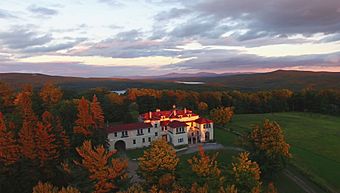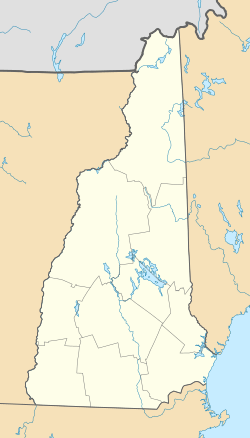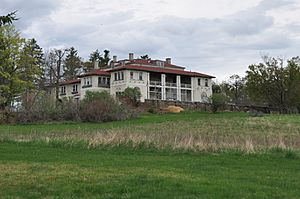Aldworth Manor facts for kids
Quick facts for kids |
|
|
Aldworth Manor
|
|

Aerial view, 2015.
|
|
| Location | Aldworth Road, on a hill above the north side of the Chesham-Harrisville Rd., Harrisville, New Hampshire |
|---|---|
| Area | 4 acres (1.6 ha) |
| Built | c.1850; 1905; 1915 |
| Architect | Fuller & Delano Company (1905); Kilham & Hopkins (1915) |
| Architectural style | Late 19th And 20th Century Revivals, American Neo-Renaissance |
| MPS | Harrisville MRA |
| NRHP reference No. | 86003244 |
| Added to NRHP | January 14, 1988 |
Aldworth Manor, also known as the Arthur E. Childs House, is a really old and interesting house in Harrisville, New Hampshire. It sits on top of a hill, and it was once one of the most important homes in the area. The house has a unique story because it wasn't always in New Hampshire. It was first built around 1850 in Worcester, Massachusetts. Later, a wealthy man named Arthur E. Childs inherited it.
Contents
The Amazing Journey of Aldworth Manor
The house that became Aldworth Manor was built in Worcester, Massachusetts, by William W. Wheeler around 1851. It was located on Lincoln Street. In 1867, a man named Philip L. Moen bought the house. After he passed away, the house went to his son, Philip W. Moen.
When Philip W. Moen died in 1904, the house was left to his sister, Alice. Alice was married to Arthur E. Childs. There was a special rule: Alice had to live in the house to get a lot of money (one million dollars!). But Alice and Arthur lived in Boston and didn't want to move to Worcester.
They owned a farm in Harrisville, New Hampshire, where Arthur wanted to build a hunting lodge. So, they came up with an amazing plan! They decided to move the entire house from Worcester to Harrisville.
Moving a Mansion by Train
Starting in 1905, the house was carefully taken apart. Imagine, it was loaded onto seventeen railroad cars! Then, it was hauled by train all the way to the farm in Harrisville. This farm was called Chesham Hill Farm back then.
Once it arrived, the house was put back together. It was also given a new look in the Colonial Revival style. The architects who helped with this big move and first makeover were from the Fuller & Delano Company. This first part of the project was finished by 1908.
In 1915, the Childs family decided to change the house again. This time, they made it look like a fancy Renaissance villa. The architects for this second renovation were Kilham & Hopkins from Boston.
Beautiful Gardens and Grounds
Besides moving the house, Arthur Childs also worked on the land around it. The property was huge, about 500 acres! He planted beautiful rhododendrons along the driveway. He also created a fancy terraced garden with different levels.
Beyond the garden, there was a calm reflecting pool. There was also a pergola with tall columns, which is like an open structure with a roof often covered by climbing plants. A small garden house with a tile roof was also built. A building for carriages, from 1915, stands near the main house.
What Happened Next
Over the years, Aldworth Manor has been used for many different things. The property is smaller now than it used to be. The main house has been owned by different groups and organizations.
For a while, it was used as a special hospital called a sanatorium. It also served as a campus for several schools. These included the Thomas More School, a boarding school for boys in the 1960s, and Antioch University New England. It was even used by a group that published missionary books.
Because of all these different uses, some parts of the inside of the house were changed. In the 1980s, a group called the Mountain Missionary Society did some work to fix up the house.
Aldworth Manor Today
In 2014, the manor was in danger of being torn down. But a new owner bought it and started restoring it in 2015. Now, Aldworth Manor is a popular place for weddings and other special events.
A part of the property, including the main house and some other buildings, was added to the National Register of Historic Places in 1988. This means it's recognized as an important historical site.
Images for kids





